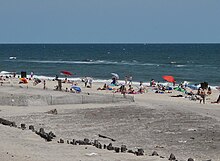Fort Tilden
| Fort Tilden | |
|---|---|
| Part of Harbor Defenses of Southern New York | |
| Queens, New York | |
 View of the abandoned fort in June 2020 | |
| Type |
|
| Site information | |
| Controlled by | U.S. Army |
| Site history | |
| Built | 1917–1924 |
| In use | 1917–1995 |
Fort Tilden Historic District | |
New York, New York | |
| Coordinates | 40°34′N 73°53′W / 40.567°N 73.883°W |
| Built | 1917 |
| Architect | U. S. Army |
| NRHP reference No. | 84002917 |
| Added to NRHP | April 20, 1984[1] |
| Garrison information | |
| Garrison | 5/5th Field Artillery, 187th Infantry Brigade (late 1960s through 1995) |

Fort Tilden, also known as Fort Tilden Historic District, is a former United States Army installation on the coast in the New York City borough of Queens. Fort Tilden now forms part of the Gateway National Recreation Area, and is administered by the National Park Service.
Fort Tilden Historic District is located on the Rockaway Peninsula, between Jacob Riis Park to the east and Breezy Point Tip to the west. All three of these sites are operated by the National Park Service.[2]
Since its decommissioning, the former installation has largely become a natural area of beaches, dunes and maritime forest. Most of the old military installations are abandoned, and military structures which formerly housed artillery (batteries) and ammunition (magazines) are covered in graffiti. A few buildings have been renovated and are used by local arts groups, and some large open areas are used as sports grounds. Atop one of the old batteries, Battery Harris East, a viewing platform has 360-degree views that include the city, New York Harbor, and the Atlantic Ocean. The wilder parts of Fort Tilden are popular with bird-watchers and other nature-lovers, and the beach areas are frequently used for fishing.[3]

Military history
The fort first served as a
World War I
The fort was established as Camp Rockaway Beach shortly after the United States entered World War I in April 1917. Several temporary military installations had been built at or near the site since the War of 1812 against the British. It was named after Samuel J. Tilden, one-term Governor of New York State and Democratic Presidential candidate in 1876.
The first unit deployed to the fort was an unnamed battery from the
The facility became part of the
Inter-war period
In March 1921, the city of New York would become one of the first locations in the United States to be defended by
World War II
In 1941–1942, a massive concrete
Several smaller batteries were built in and near Fort Tilden during the war. Battery 220 was completed but not armed; it was primarily an ammunition bunker for two
After the war it was determined that gun defenses were obsolete, and Fort Tilden was disarmed, with all guns removed for scrap in 1948.[6]
Cold War
In 1950, as the fear of Soviet air attack grew, a battalion of sixteen
In 1955, the AA guns were replaced by a
Army Reserve post
From the late 1960s until at least 1978, Fort Tilden was an
Fort Tilden remained an Army installation until the late 1970s, when it was decommissioned and turned over to the
Nature area
Fort Tilden is an important nesting area for the threatened
Common terns[13] and least terns[14] also make their nests on the beach at Fort Tilden. These two species are threatened in New York State as well.
See also
References
- ^ "National Register Information System". National Register of Historic Places. National Park Service. April 15, 2008.
- ^ New York Harbor Map National Parks of New York Harbor Conservancy. Accessed November 18, 2008
- ^ Kilgannon, Corey. To the Battlements, and Take Sunscreen: The Joys of Fort Tilden. July 21, 2006. New York Times. Accessed November 18, 2008.
- ^ a b PDF of Gateway NRA rules
- ^ a b c d Berhow, p. 209
- ^ a b c d e f g h i j Fort Tilden at FortWiki.com
- ^ a b c d e f g Fort Tilden website archived from Geocities at web.archive.org
- ^ Smith, Bolling. "The 16-inch Batteries at San Francisco and the Evolution of the Casemated 16-inch Battery" (PDF). The Coast Defense Journal. 15 (1): 16–83. Retrieved 4 February 2016.
- ^ Berhow, p. 210
- ^ Fort Tilden at American Forts Network
- ^ "Why Piping Plovers Come to Gateway". nps.gov.
- ^ Photo of warning sign about birds
- ^ "Common Tern Fact Sheet". ny.gov.
- ^ "Least Tern Fact Sheet". ny.gov.
- Berhow, Mark A., ed. (2015). American Seacoast Defenses, A Reference Guide (Third ed.). McLean, Virginia: CDSG Press. ISBN 978-0-9748167-3-9.
- Lewis, Emanuel Raymond (1979). Seacoast Fortifications of the United States. Annapolis: Leeward Publications. ISBN 978-0-929521-11-4.
- Roberts, Robert B. (1988). Encyclopedia of Historic Forts: The Military, Pioneer, and Trading Posts of the United States. New York: Macmillan. ISBN 0-02-926880-X.
External links
- Fort Tilden Visitor information
- Historic American Engineering Record(HAER) documentation, filed under 169 Breezy Point Boulevard, Roxbury, Queens County, NY:
- HAER No. NY-566-A, "Fort Tilden, Battery Kessler", 5 photos, 1 color transparency, 5 measured drawings, 20 data pages, 1 photo caption page
- HAER No. NY-566-B, "Fort Tilden, Battery 220", 5 photos, 2 color transparencies, 5 measured drawings, 19 data pages, 1 photo caption page
